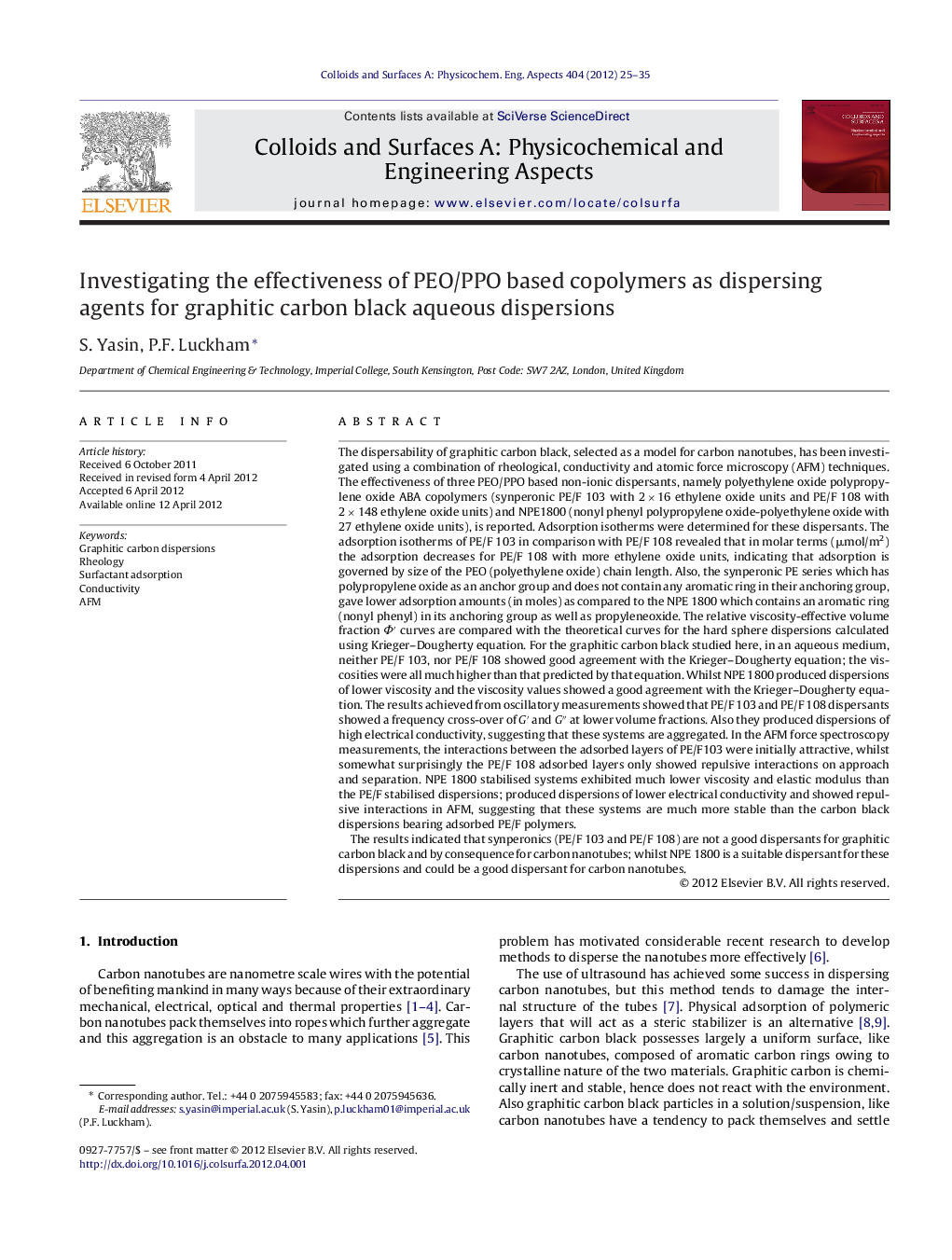| کد مقاله | کد نشریه | سال انتشار | مقاله انگلیسی | نسخه تمام متن |
|---|---|---|---|---|
| 594106 | 1453969 | 2012 | 11 صفحه PDF | دانلود رایگان |

The dispersability of graphitic carbon black, selected as a model for carbon nanotubes, has been investigated using a combination of rheological, conductivity and atomic force microscopy (AFM) techniques. The effectiveness of three PEO/PPO based non-ionic dispersants, namely polyethylene oxide polypropylene oxide ABA copolymers (synperonic PE/F 103 with 2 × 16 ethylene oxide units and PE/F 108 with 2 × 148 ethylene oxide units) and NPE1800 (nonyl phenyl polypropylene oxide-polyethylene oxide with 27 ethylene oxide units), is reported. Adsorption isotherms were determined for these dispersants. The adsorption isotherms of PE/F 103 in comparison with PE/F 108 revealed that in molar terms (μmol/m2) the adsorption decreases for PE/F 108 with more ethylene oxide units, indicating that adsorption is governed by size of the PEO (polyethylene oxide) chain length. Also, the synperonic PE series which has polypropylene oxide as an anchor group and does not contain any aromatic ring in their anchoring group, gave lower adsorption amounts (in moles) as compared to the NPE 1800 which contains an aromatic ring (nonyl phenyl) in its anchoring group as well as propyleneoxide. The relative viscosity-effective volume fraction Φ′ curves are compared with the theoretical curves for the hard sphere dispersions calculated using Krieger–Dougherty equation. For the graphitic carbon black studied here, in an aqueous medium, neither PE/F 103, nor PE/F 108 showed good agreement with the Krieger–Dougherty equation; the viscosities were all much higher than that predicted by that equation. Whilst NPE 1800 produced dispersions of lower viscosity and the viscosity values showed a good agreement with the Krieger–Dougherty equation. The results achieved from oscillatory measurements showed that PE/F 103 and PE/F 108 dispersants showed a frequency cross-over of G′ and G″ at lower volume fractions. Also they produced dispersions of high electrical conductivity, suggesting that these systems are aggregated. In the AFM force spectroscopy measurements, the interactions between the adsorbed layers of PE/F103 were initially attractive, whilst somewhat surprisingly the PE/F 108 adsorbed layers only showed repulsive interactions on approach and separation. NPE 1800 stabilised systems exhibited much lower viscosity and elastic modulus than the PE/F stabilised dispersions; produced dispersions of lower electrical conductivity and showed repulsive interactions in AFM, suggesting that these systems are much more stable than the carbon black dispersions bearing adsorbed PE/F polymers.The results indicated that synperonics (PE/F 103 and PE/F 108) are not a good dispersants for graphitic carbon black and by consequence for carbon nanotubes; whilst NPE 1800 is a suitable dispersant for these dispersions and could be a good dispersant for carbon nanotubes.
Figure optionsDownload as PowerPoint slideHighlights
► Carbon black dispersions stabilised by dispersants studied by AFM and rheology.
► Poor stability found if dispersant does only has a PPO anchor group.
► Good dispersion found with hydrocarbon based anchor group.
► Broad correlation between AFM force measurements and rheology.
Journal: Colloids and Surfaces A: Physicochemical and Engineering Aspects - Volume 404, 20 June 2012, Pages 25–35